|
|
|||
|
THIS WEEK at HILTON POND (Back to Preceding Week; on to Next Week) |
|
SHADE-GROWN COFFEE:
DOING IT "THE RIGHT WAY" The past three years we've led groups of educators and citizen scientists to Guanacaste Province on the Pacific side of Costa Rica to study Ruby-throated Hummingbirds on their wintering grounds. We've become close friends with our expert local guide--Ernesto Carman Jr. (below right)--
All text & photos © Hilton Pond Center Coffee drinking apparently originated in the highlands of Ethiopia--probably in the Kaffa Region--where indigenous peoples discovered coffee beans produced a bitter elixir with stimulating properties. From there, the drink spread to the Middle East and eventually to Europe, where it became quite popular in the 1600s. Today two main species of coffee are consumed worldwide: Coffea arabica (better-tasting, subject to more diseases, native to southwestern Ethiopia), and C. canefora, also known as C. robusta (from Uganda, easier to cultivate, more resistant to pests and disease, with about 50% more caffeine). Of these, arabica blends are considerably more expensive, so many restaurants and homeowners serve up robusta--sometimes mixed with a little arabica to make it more palatable. Most "instant coffee" is primarily the cheaper robusta.
All eight of these outcomes of growing coffee in sun-drenched monocultures have serious negative repercussions for local environments, but the one that affects North Americans most is the first: Destruction of habitat. Although Central and South America may be thousands of miles away from the U.S. and Canada, tropical landscapes converted to coffee are where many of "our" migrant songbird species have overwintered, at least for tens of thousands of years. Faced with this complex dilemma, Ernie (below right) and Linda Carman eventually decided that if they were going to have a coffee farm in Costa Rica, they would do it "the right way" by eliminating as many environmental problems as they could. Read on to learn how Finca Cristina minimized or eliminated each of the problems associated with growing coffee in typical fashion.
All text & photos © Hilton Pond Center 1. SHADE COFFEE VS. SUN COFFEE When American and European demand for more environmentally friendly shade-grown coffee began to influence how tropical farmers managed their crops, many Costa Rican coffee growers followed misguided advice and planted eucalyptus trees that sprouted quickly into the canopy (above). Unfortunately, eucalyptus is from Australia--native New World orchids and insects aren't adapted to them--and it has smooth or flaking bark that doesn't support the epiphytes anyway. 2. HERBICIDES For the most part, grasses and forbs don't do well under shade trees at Finca Cristina. Those that do sprout are often native wildflowers; those that aren't are easily pulled by hand as coffee pickers make their rounds on extensive trails that wind throughout the farm. Because grass and weed herbicides used by coffee mega-growers are often non-selective, their usage ends up destroying nearly ALL herbaceous growth--including plants used by pollinators and other insects; that turns out NOT to be a problem at herbicide-free Finca Cristina. 3. FUNGICIDES As noted previously, coffee plants grown in monoculture on huge plantations are susceptible to highly contagious fungal infections, which is why big growers use fungicides--chemicals that also can kill beneficial soil fungi. 4. INSECTICIDES One of the biggest enemies of coffee growers is an almost infinitesimally small beetle that lays its egg in a ripening coffee berry, where the insect's larva disfigures the bean and reduces its yield. 5, 6 & 7. CHEMICAL FERTILIZERS, ORGANIC WASTE The topography of Costa Rica is relatively new, having been formed largely by volcanic eruption; Arenal Volcano is estimated to be only 3,000 years old, and the rest of the country's seven active volcanos apparently have formed since the Pleistocene Epoch (less than two million years ago).
All text & photos © Hilton Pond Center 8. FUEL CONSUMPTION After the husk is removed, coffee beans must be dried to eliminate mold before the beans are placed in burlap bags where flavor compounds improve with age. Although big coffee plantations use gas-fired or electric drums to speed drying, such processes waste energy in a land where sunshine is readily available and a free commodity. The bottom line is that even though many farmers in Costa Rica and elsewhere advertise they are converting from sun-grown to shade-grown coffee, not every coffee grower is doing it "the right way"; i.e., considering ALL the angles in trying to farm in as environmentally friendly a way as possible. Linda and Ernie Carman seem to have made the strongest possible commitment to the environment as they produce high-quality organic shade-grown coffee for use in Costa Rica and around the world, so their motto is both appropriate and honest: "A Healthy Earth Grows Great Coffee!" But--get this--the Carmans have gone even one step further in setting aside six of their 30 acres as a true nature preserve that their son Ernesto is restoring by planting native trees, orchids, and other flora. In reality, the entire coffee farm is a wondrous, natural place:
We commend and endorse Ernie and Linda Carman and their children for their environmental efforts and encourage coffee-lovers we know to patronize Cafe Cristina products through the finca's Web page, accessible by clicking on the photo just above. And if you're ever in or around San Jose, Costa Rica, be sure to call for a guided tour of Finca Cristina at Paraiso. Hilton Pond Center derives no benefit from this endorsement, except in knowing that every coffee drinker who patronizes the Carmans is doing his or her small part to protect Costa Rica flora and fauna--to say nothing of "our" 87 species of Neotropical migrants that breed in North America and overwinter in the bird-friendly shade-grown acreage that makes up Finca Cristina. All text & photos © Hilton Pond Center POSTSCRIPT: After bidding farewell to Finca Cristina, we journeyed with Ernesto Carman Jr. to San Jose, joining with two Costa Rican teachers for a four-hour bus ride over the mountains to Guanacaste Province, where we awaited the next day's arrival of nine air travelers from Canada and the U.S. These folks were participants on our fourth tropical hummingbird banding expedition, which will be the topic of next week's photo essay. Until then, please scroll down for a sampling of photos taken during our time with the Carman family. FINCA CRISTINA AND BEYOND: During our three-day visit with Ernesto Carman and his parents in Paraiso, Costa Rica, we took lots of photos at Finca Cristina and other locales nearby.
All text & photos © Hilton Pond Center Delicate white flowers of Arabian Coffee, Coffea arabica, the species grown at Finca Cristina
All text & photos © Hilton Pond Center Nearly ripe (purplish-red) and unripe (green) beans of Coffea arabica at Finca Cristina
All text & photos © Hilton Pond Center Organic coffee grower Ernie Carman, judging the accuracy of his custom-modified shaker table that sorts beans by size and density at Finca Cristina
All text & photos © Hilton Pond Center Two sizes and densities of coffee beans after they've been sorted; the difference might not look like much to the uneducated eye, but to Ernie Carman--and the discriminating drinker of fine coffee--there is LOTS of difference
All text & photos © Hilton Pond Center Linda Carman, the queen of Costa Rica organic coffee growers, works hard running Finca Cristina's propane-powered coffee roaster; her personal attention guarantees the process is done right
All text & photos © Hilton Pond Center Leaf-cutter Ants on the march at Finca Cristina; the large one at center is carrying the tiny seeds of a fig tree; insecticides would wipe out these creatures on a typical non-organic coffee farm
All text & photos © Hilton Pond Center An unidentified but VERY long-tailed male anole, hanging out in the shade among coffee trees at Finca Cristina
All text & photos © Hilton Pond Center Highly magnified view of the miniscule (2mm) flowers of a Jocote, Spondias purpurea, near Paraiso; we documented this tree as an important food source for Ruby-throated Hummingbirds on our study site in Guanacaste Province on Costa Rica's Pacific Coast, where we never saw its flowers open this wide
All text & photos © Hilton Pond Center A colony of four-foot-long hanging bag nests of the Montezuma Oropendola, a tropical relative of the much-smaller Baltimore Oriole
All text & photos © Hilton Pond Center Black Phoebe on a stone wall around the ruins of the 1681 Church of Ujarras at Paraiso
All text & photos © Hilton Pond Center Looking down from a bridge at unidentified bromeliads, epiphytic in the top of a canopy tree
All text & photos © Hilton Pond Center A small unidentified orchid with flowers less than half-an-inch long, epiphytic on a Coralbean shade tree at Finca Cristina; Ernesto Carman Jr. has rescued many orchids and other epiphytes from development areas and moved them to safety on the family's coffee farm
All text & photos © Hilton Pond Center Wide-angle view of the water-filled cauldron of Irazu Volcano, which on this day was mostly ABOVE the clouds; not far from Finca Cristina, Irazu is Costa Rica's tallest volcano at an elevation of almost two miles (11,260 feet)
All text & photos © Hilton Pond Center A territorial male Volcano Hummingbird, bobbing in the wind from his lookout perch high atop Irazu Volcano; on Irazu males of this species have dull purple gorgets, but in the Talamanca Region the male's throat is purplish-gray or purplish-green while on Poas Volcano it is rose-red; hummers on the road to speciation, perhaps?
All text & photos © Hilton Pond Center This female Volcano Hummingbird was the object of the above male's attentions; note that a female Volcano Hummingbird looks confusingly like females in an awful lot of other hummer species! MEMORABLE QUOTES FROM ERNIE & LINDA CARMAN, "The three aspects of sustainable agriculture are economic, environmental, and social. ALL have to be present for sustainability to work." "Organic farming isn't just what you DON'T do to the soil, it's also what you DO to it." "It's hard to get a farmer to understand and agree that he may need to work for 30 years to fix his soil so he can get it back to its original organic state."
Comments or questions about this week's installment?
Thanks to the following fine folks for recent gifts in support of Hilton Pond Center for Piedmont Natural History and/or Operation RubyThroat: The Hummingbird Project. Your tax-deductible contributions allow us to continue writing, photographing, and sharing "This Week at Hilton Pond."
"This Week at Hilton Pond" is written & photographed You may wish to consult our Index of all nature topics covered since February 2000. You can also use our on-line Hilton Pond Search Engine at the bottom of this page. For a free, non-fattening, on-line subscription to |

 an affable, energetic, bilingual 25-year-old naturalist with near-encyclopedic knowledge of plants and animals in his home country. When he's not guiding, Ernesto lives on Costa Rica's Caribbean side, so we decided this year to jet to the tropics a few days early to visit with him and his parents on their 30-acre coffee farm at Paraiso, southeast of San Jose. Their place is called
an affable, energetic, bilingual 25-year-old naturalist with near-encyclopedic knowledge of plants and animals in his home country. When he's not guiding, Ernesto lives on Costa Rica's Caribbean side, so we decided this year to jet to the tropics a few days early to visit with him and his parents on their 30-acre coffee farm at Paraiso, southeast of San Jose. Their place is called 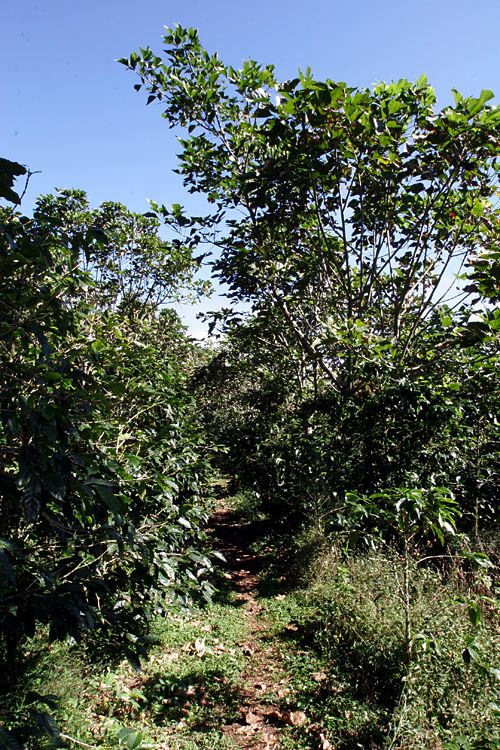
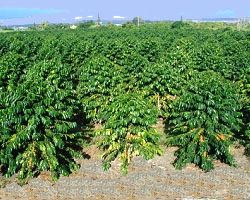 Historically, coffee trees were plants of the dark forest, where in canopy shade they grew slowly and took longer for their fruits to ripen. Back then, people simply went to the woods and harvested coffee beans in small quantities for personal use, but as the demand for coffee spread, growers discovered they could produce far more beans by planting trees in full sun and, eventually, on large coffee plantations (above left). This agricultural practice created numerous environmental problems that have increased exponentially in the modern era:
Historically, coffee trees were plants of the dark forest, where in canopy shade they grew slowly and took longer for their fruits to ripen. Back then, people simply went to the woods and harvested coffee beans in small quantities for personal use, but as the demand for coffee spread, growers discovered they could produce far more beans by planting trees in full sun and, eventually, on large coffee plantations (above left). This agricultural practice created numerous environmental problems that have increased exponentially in the modern era: 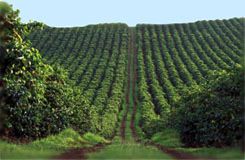 AND eliminating epiphytes such as orchids, bromeliads, lichens, mosses, and ferns and their multitude of symbionts
AND eliminating epiphytes such as orchids, bromeliads, lichens, mosses, and ferns and their multitude of symbionts
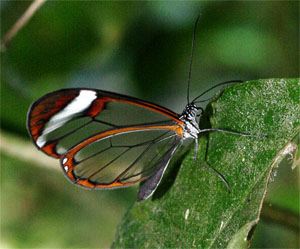 growers respond with insecticides that also kill beneficial invertebrates (such as the clear-wing butterfly, below right, photographed at Finca Cristina)
growers respond with insecticides that also kill beneficial invertebrates (such as the clear-wing butterfly, below right, photographed at Finca Cristina)
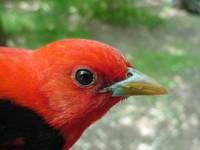 These days, however, everything from Scarlet Tanagers (left) to Yellow-billed Cuckoos and Wood Thrushes to Cerulean Warblers leave their breeding grounds in Canada and the U.S., migrate long distance to the Neotropics, and arrive with nowhere to spend the OTHER half of their year--in part because so much coffee is grown in full sun on big plantations.
These days, however, everything from Scarlet Tanagers (left) to Yellow-billed Cuckoos and Wood Thrushes to Cerulean Warblers leave their breeding grounds in Canada and the U.S., migrate long distance to the Neotropics, and arrive with nowhere to spend the OTHER half of their year--in part because so much coffee is grown in full sun on big plantations.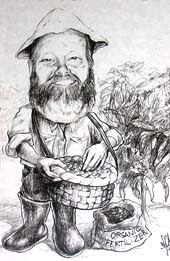 It wasn't an easy decision; converting the sun-grown coffee farm they purchased to one that was environmentally friendly would require lots of work--and time. At first, the Carmans planted shade trees among their coffee plants but decided just that wasn't enough--so in 1992 they took the very unusual pioneering step of trying to become a fully ORGANIC coffee farm: Free of chemical controls and artificial fertilizers; requiring minimal use of electricity, natural gas, or other fuels; and yielding little unusable waste. Going organic was a BIG change and a financial gamble, for it would require even longer time to allow the farm's depleted soil to be restored to a more natural state.
It wasn't an easy decision; converting the sun-grown coffee farm they purchased to one that was environmentally friendly would require lots of work--and time. At first, the Carmans planted shade trees among their coffee plants but decided just that wasn't enough--so in 1992 they took the very unusual pioneering step of trying to become a fully ORGANIC coffee farm: Free of chemical controls and artificial fertilizers; requiring minimal use of electricity, natural gas, or other fuels; and yielding little unusable waste. Going organic was a BIG change and a financial gamble, for it would require even longer time to allow the farm's depleted soil to be restored to a more natural state.
 Even worse, eucalyptus is a nutrient hog that sucks up minerals from the soil, requiring even MORE artificial fertilizers to nourish coffee trees growing beneath them. At Finca Cristina, many shade trees are Coralbean, Erythrina poepiggiana (see photo at top of page), a Neotropical legume that fixes nitrogen and actually ENRICHES soil rather than depleting it. (This tree is the big brother of the Cherokee Bean, E. herbacea, whose tubular red flowers can be seen on tall stalks in the sandy Carolina Lowcountry.) Coralbean grows quite fast, so workers cut off branches periodically and drop them to the ground, where they decompose and return even more nutrients to the earth. Finca Cristina arborists are careful not to damage Coralbean trunks (above left), which support a large and diverse assemblage of native epiphytic orchids, bromeliads, lichens, mosses, orchids, and ferns.
Even worse, eucalyptus is a nutrient hog that sucks up minerals from the soil, requiring even MORE artificial fertilizers to nourish coffee trees growing beneath them. At Finca Cristina, many shade trees are Coralbean, Erythrina poepiggiana (see photo at top of page), a Neotropical legume that fixes nitrogen and actually ENRICHES soil rather than depleting it. (This tree is the big brother of the Cherokee Bean, E. herbacea, whose tubular red flowers can be seen on tall stalks in the sandy Carolina Lowcountry.) Coralbean grows quite fast, so workers cut off branches periodically and drop them to the ground, where they decompose and return even more nutrients to the earth. Finca Cristina arborists are careful not to damage Coralbean trunks (above left), which support a large and diverse assemblage of native epiphytic orchids, bromeliads, lichens, mosses, orchids, and ferns. 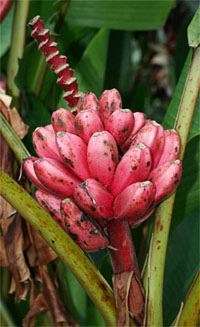 Other types of canopy trees are scattered around the farm, adding biodiversity and casting shade on the coffee plants beneath. Those that are fruit trees--such as bananas (right)--provide food for birds and mammals (including the resourceful coffee bean picker who can dine on tasty forest products rather than packing a lunch).
Other types of canopy trees are scattered around the farm, adding biodiversity and casting shade on the coffee plants beneath. Those that are fruit trees--such as bananas (right)--provide food for birds and mammals (including the resourceful coffee bean picker who can dine on tasty forest products rather than packing a lunch).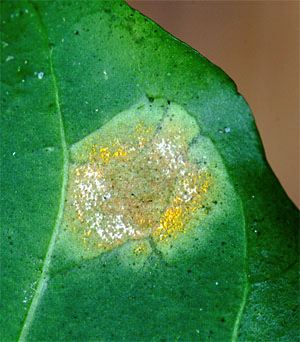 At Finca Cristina, the Carmans decided to go with biological control to handle leaf fungi. At least once a year, they spray their coffee trees with spores of a "good" fungus that attacks and outcompetes the "bad" fungi; the two fungal strains are shown in the photo at right, with the soon-to-be-vanquished pathogenic one at the center of the spot. Although annual application of "good" fungal spores is relatively expensive, it is effective and a natural, organic process that kills only target fungi--not desirable decomposers that help enrich the soil.
At Finca Cristina, the Carmans decided to go with biological control to handle leaf fungi. At least once a year, they spray their coffee trees with spores of a "good" fungus that attacks and outcompetes the "bad" fungi; the two fungal strains are shown in the photo at right, with the soon-to-be-vanquished pathogenic one at the center of the spot. Although annual application of "good" fungal spores is relatively expensive, it is effective and a natural, organic process that kills only target fungi--not desirable decomposers that help enrich the soil.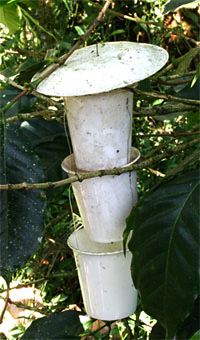 Coffee Berry Borer, Hypothenemus hampei, annually causes hundreds of millions of dollars in damage to coffee worldwide, so the usual response by plantation owners is to smother their trees with chemical insecticides on a regular basis. At Finca Cristina, the Carmans have a two-pronged approach to beetle control. One is to use simple bait traps (left)--a series of cups filled with kerosene that drowns the beetles. The other is to "outsmart" the beetles by understanding their life cycle and managing coffee trees accordingly. Unlike big growers that allow trees to flower continuously throughout the year--an "unnatural" phenology for coffee trees--the Carmans let their trees rest for a couple of months each year, even going so far as to pluck any wayward flowers that might yield fruit during that rest period. This breaks the life cycle of the coffee beetle by eliminating berries in which it can lay its eggs; without beans, the vast majority of beetles simply die without reproducing successfully, which keeps the overall insect population in check--WITHOUT chemical insecticides. This simple but elegant approach has no negative environmental impact--except on the bean beetles, of course.
Coffee Berry Borer, Hypothenemus hampei, annually causes hundreds of millions of dollars in damage to coffee worldwide, so the usual response by plantation owners is to smother their trees with chemical insecticides on a regular basis. At Finca Cristina, the Carmans have a two-pronged approach to beetle control. One is to use simple bait traps (left)--a series of cups filled with kerosene that drowns the beetles. The other is to "outsmart" the beetles by understanding their life cycle and managing coffee trees accordingly. Unlike big growers that allow trees to flower continuously throughout the year--an "unnatural" phenology for coffee trees--the Carmans let their trees rest for a couple of months each year, even going so far as to pluck any wayward flowers that might yield fruit during that rest period. This breaks the life cycle of the coffee beetle by eliminating berries in which it can lay its eggs; without beans, the vast majority of beetles simply die without reproducing successfully, which keeps the overall insect population in check--WITHOUT chemical insecticides. This simple but elegant approach has no negative environmental impact--except on the bean beetles, of course.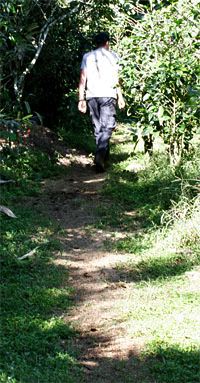 With volcanic eruption comes the dispersal of ash and mud flow that are rich in minerals--just the thing to make plants happy. After volcanoes blanketed the landscape with potassium and pumice, trees, shrubs, vines, and herbaceous growth flourished in the warm tropical climate and Costa Rica became covered by primary forest. But then, as humans developed agricultural skills, forests were replaced by cultivated crops that, over time, depleted the soil of its nutrients--which is why mega-farmers have to resort to synthetic fertilizers in a land whose lush vegetation incorrectly implies still-rich topsoil. At Finca Cristina, the Carmans provide natural soil amendments in several ways: Using the aforementioned nitrogen-fixing Coralbeans as shade trees; allowing pruned plant parts to decompose on the ground; bringing in and scattering waste ash produced by nearby sugar cane farmers; composting household food wastes; maintaining active earthworm colonies; and even covering trails (above right) with the husks of processed coffee beans to return nutrients--and to provide mulch that retards growth of undesirable grasses and forbs. Even nutrient-rich waste water--a necessary by-product of the bean-cleaning process--is used to irrigate Finca Cristina's coffee trees rather than being pumped to a waste treatment facility or dumped into nearby tributaries, as happens at many mega-farms.
With volcanic eruption comes the dispersal of ash and mud flow that are rich in minerals--just the thing to make plants happy. After volcanoes blanketed the landscape with potassium and pumice, trees, shrubs, vines, and herbaceous growth flourished in the warm tropical climate and Costa Rica became covered by primary forest. But then, as humans developed agricultural skills, forests were replaced by cultivated crops that, over time, depleted the soil of its nutrients--which is why mega-farmers have to resort to synthetic fertilizers in a land whose lush vegetation incorrectly implies still-rich topsoil. At Finca Cristina, the Carmans provide natural soil amendments in several ways: Using the aforementioned nitrogen-fixing Coralbeans as shade trees; allowing pruned plant parts to decompose on the ground; bringing in and scattering waste ash produced by nearby sugar cane farmers; composting household food wastes; maintaining active earthworm colonies; and even covering trails (above right) with the husks of processed coffee beans to return nutrients--and to provide mulch that retards growth of undesirable grasses and forbs. Even nutrient-rich waste water--a necessary by-product of the bean-cleaning process--is used to irrigate Finca Cristina's coffee trees rather than being pumped to a waste treatment facility or dumped into nearby tributaries, as happens at many mega-farms.
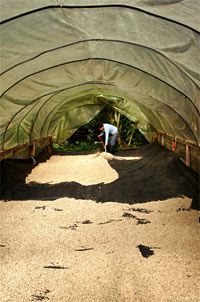 At Finca Cristina workers rake coffee beans into large open-air structures (above) with concrete pads, open sides, and translucent plastic roofs that allow the sun to do the drying work. On cloudy days--which certainly do occur during the rainy season--the beans may go into a drying tunnel designed by Ernie Carman; this open-ended device (left) faces west to allow prevailing winds to blow through and dry the beans. Only after an extended period without sunshine do the Carmans ever load their beans into a big back-up drum that uses an electric motor to tumble coffee beans until dry.
At Finca Cristina workers rake coffee beans into large open-air structures (above) with concrete pads, open sides, and translucent plastic roofs that allow the sun to do the drying work. On cloudy days--which certainly do occur during the rainy season--the beans may go into a drying tunnel designed by Ernie Carman; this open-ended device (left) faces west to allow prevailing winds to blow through and dry the beans. Only after an extended period without sunshine do the Carmans ever load their beans into a big back-up drum that uses an electric motor to tumble coffee beans until dry.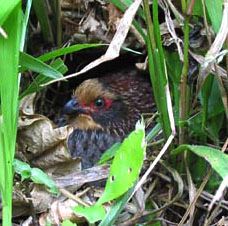 Ernesto and other birders have observed 272 species of birds at Finca Cristina, including 87 that migrate from North America
Ernesto and other birders have observed 272 species of birds at Finca Cristina, including 87 that migrate from North America
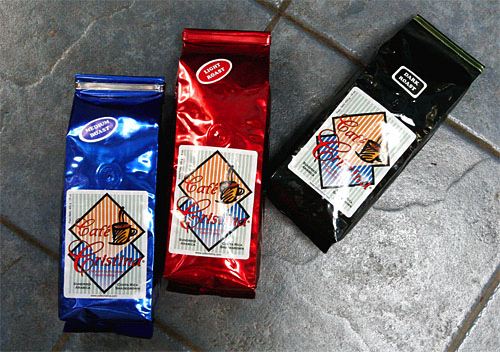
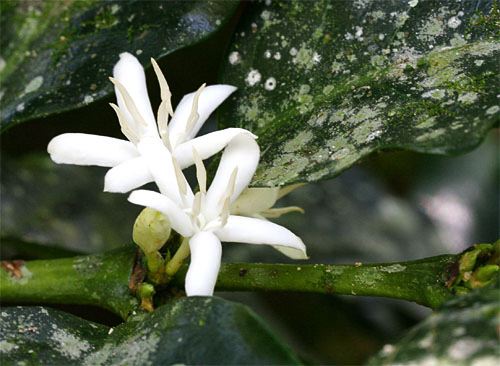

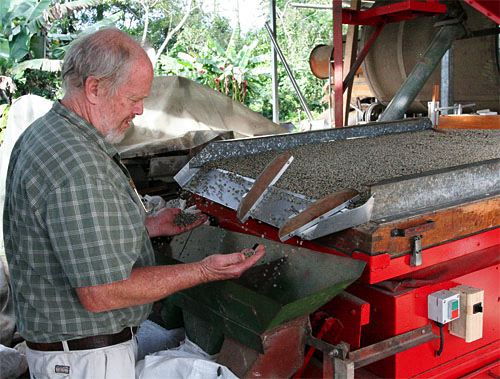
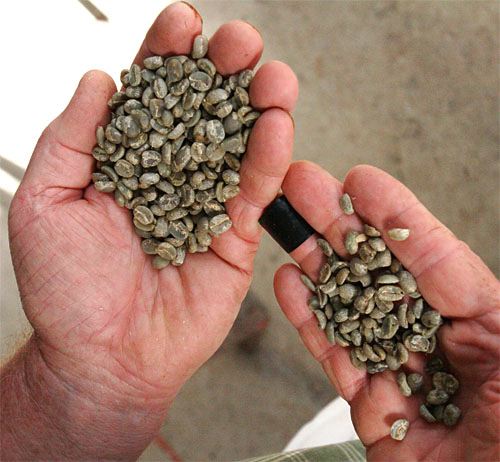
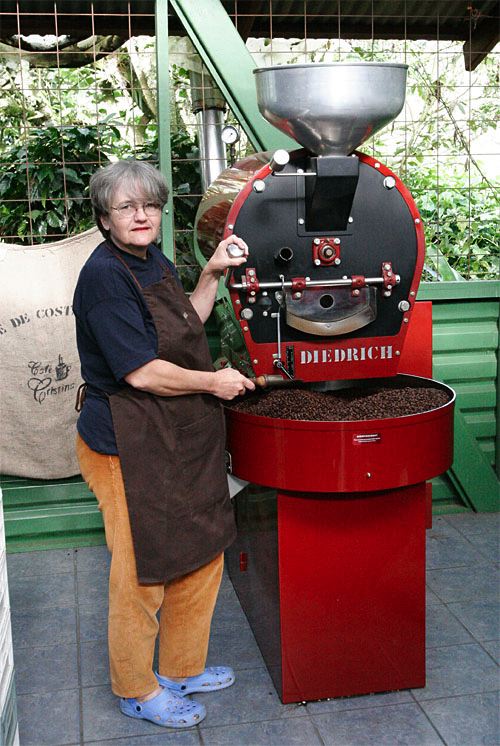
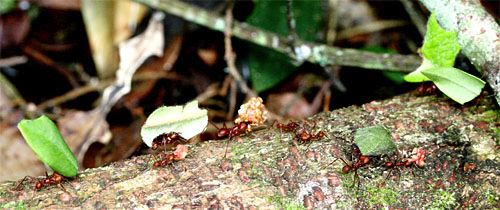
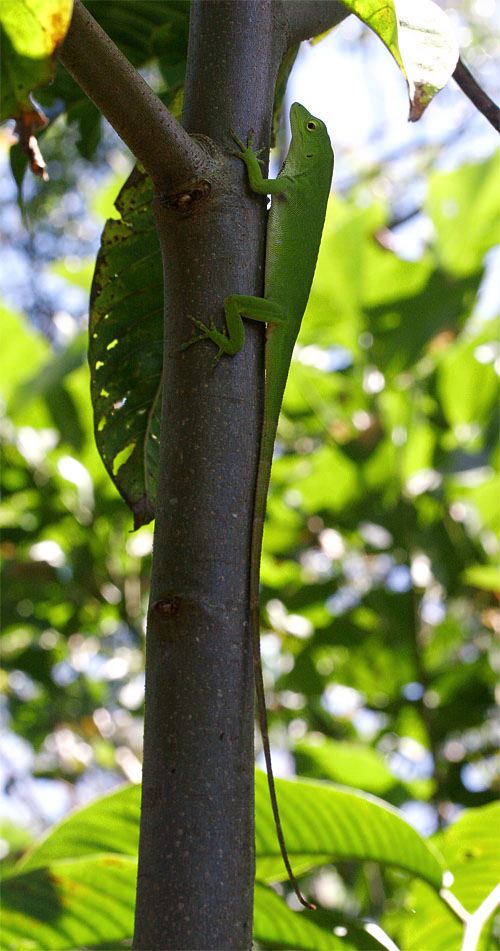
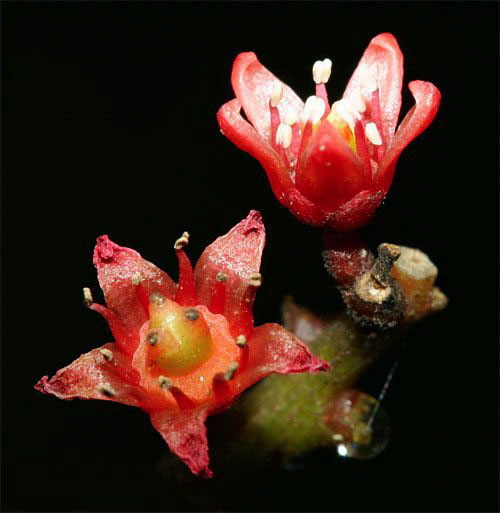


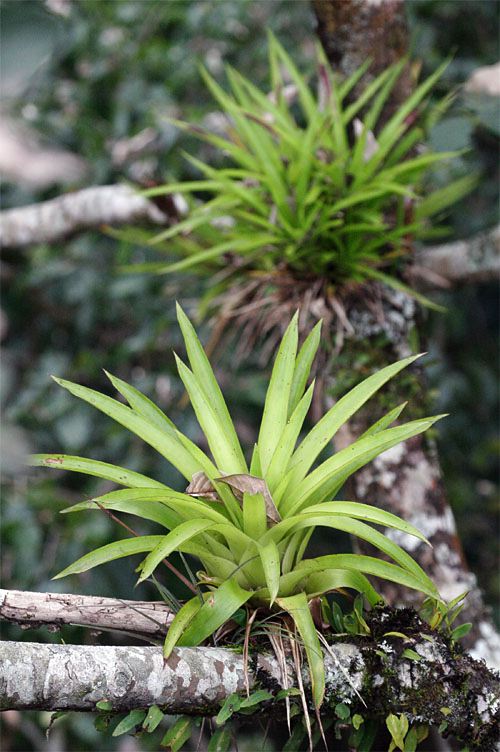
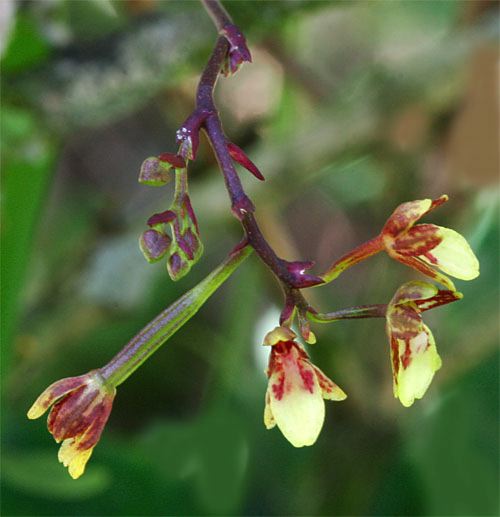

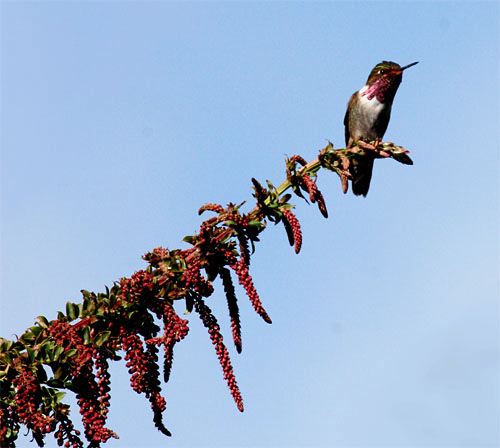
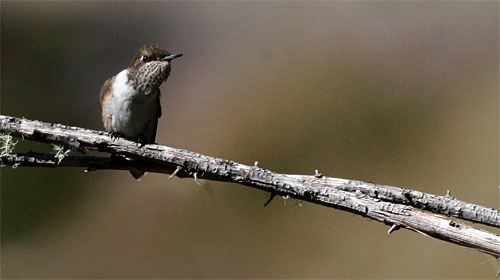


 Oct 15 to Mar 15
Oct 15 to Mar 15
